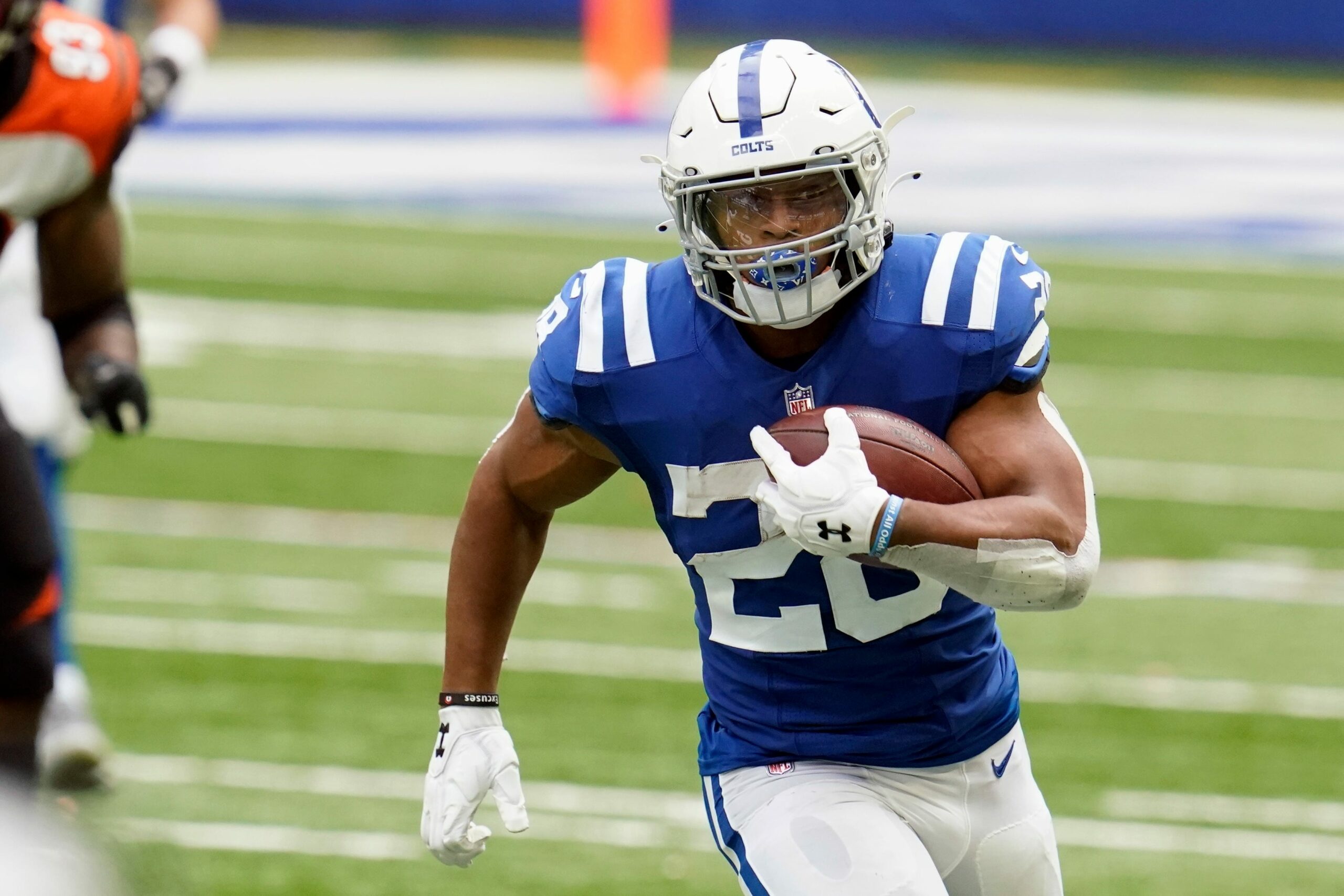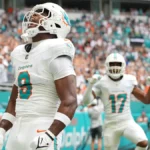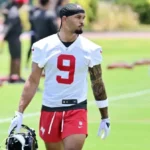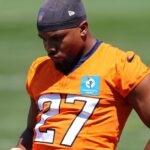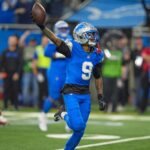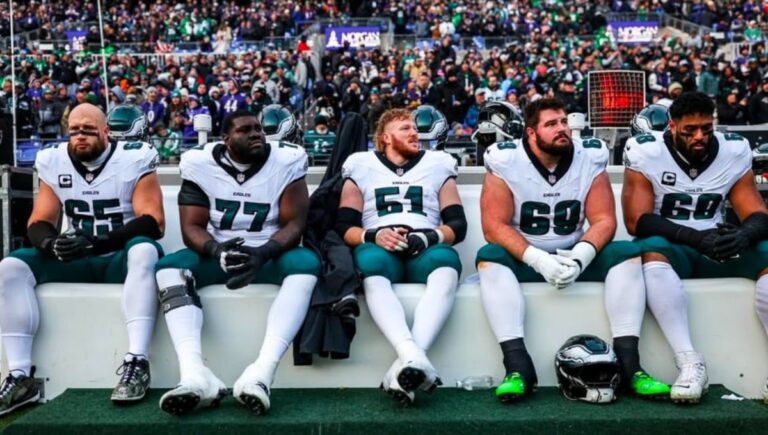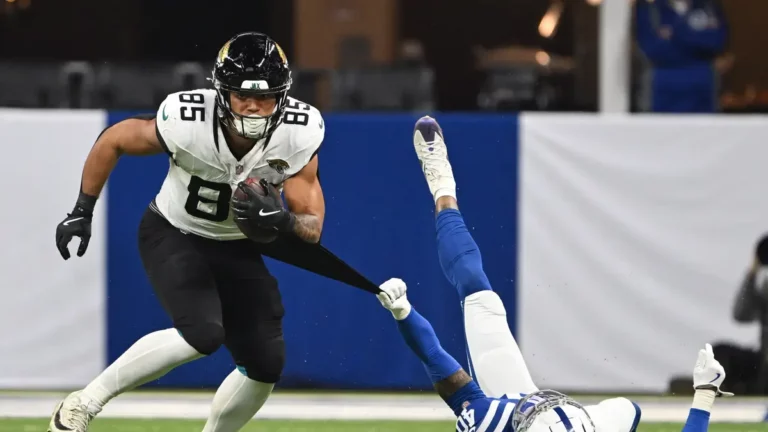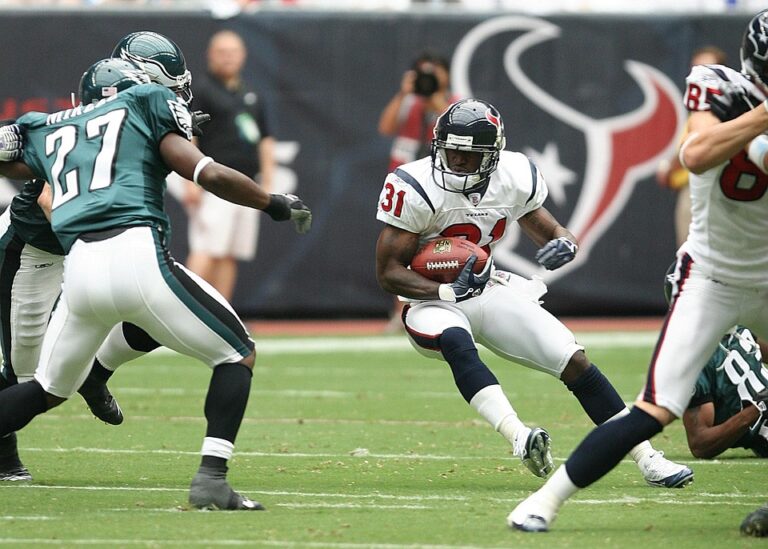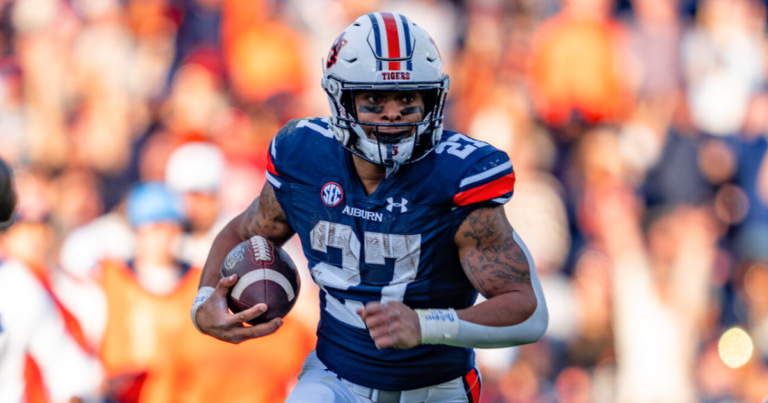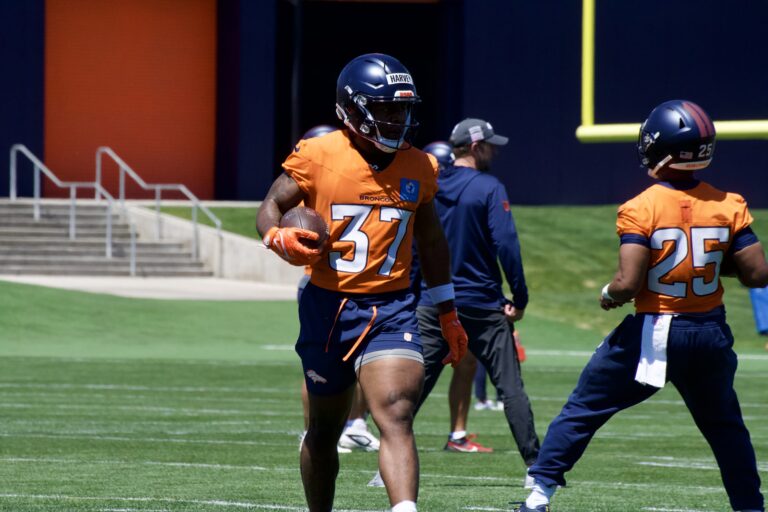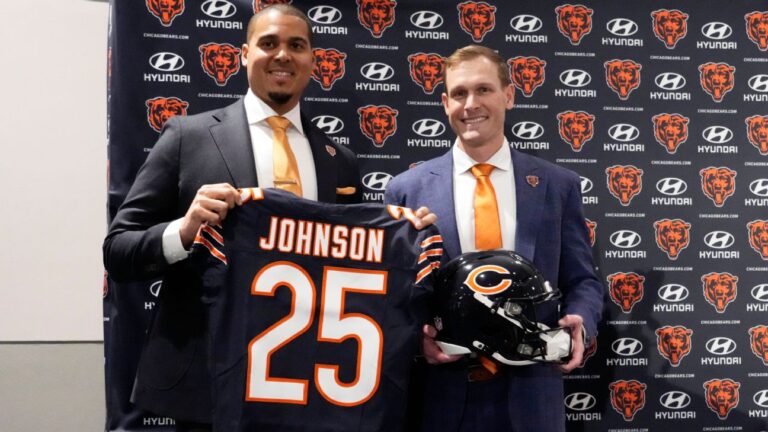Volume is the single greatest predictor of fantasy football results. But all volume is not created equal. You might have heard that a target is worth 2.74 times as much as a carry in PPR leagues, but even knowing that statistic doesn’t tell the whole story. Carries from inside the 5 are still more valuable than targets in the middle of the field. And long bombs with lots of air yards are more valuable than short dump-offs. Fortunately, we can use expected fantasy points to easily compare each player’s workload on a level playing field.
Comparing workloads on a per-game basis is best. Running backs tend to get injured a lot, but missing games one year doesn’t necessarily lead to missing games in the future.
To give you the most accurate comparison, I removed all games when players were inactive or suffered an in-game injury. In addition, I took the sample of games that I feel best represents each player’s 2021 situation. Some second-year players like Jonathan Taylor, Cam Akers, and D’Andre Swift broke out late in the season, so their early-season data is relatively useless for 2021 fantasy football rankings.
Check out part one for more information on expected fantasy points and my analysis of The Wolf’s 2021 Fantasy Football top-8 running backs. I analyze running backs 9-16 in this article.
All data in this article uses full PPR scoring.
The Wolf’s 2021 RB9-RB16 Breakdown

9. Austin Ekeler

Weeks 4 and 17 are removed for in-game injury, and Ekeler was inactive Weeks 5-11.
Ekeler’s snap share and snap percentage look very similar to Alvin Kamara’s. Neither are elite in that department, but they both have solid overall opportunity numbers thanks to their heavy involvement in the passing game.
Ekeler’s situation seems to have improved since 2020, so I expect his opportunity and production to remain solid in 2021. The Chargers brought in former Saints QB coach Joe Lombardi as offensive coordinator, so perhaps Ekeler could even see a few more targets in an Alvin Kamara-like role. An improved offensive line should also help bump up his efficiency in the run game. As long as he can stay healthy, Ekeler is primed for a great 2021 season.
10. Jonathan Taylor

The purpose of this article is to use the 2020 numbers that most closely match what we can expect in 2021 for each player. Previously, I have only removed weeks due to injury. Taylor did not become the full-time starter until Week 11, so I am only looking at data from Weeks 11-17 and Week 1 of the playoffs.
After disappointing through the first ten weeks, the Colts finally unleashed Taylor, handing him just over 60% of the snaps to finish the season. All he did was put 23.1 PPG over that stretch, which would have been RB4 of the 24 guys listed here on a per-game basis. Taylor scored 8 touchdowns in 7 games, so some regression is expected there. But he was still an absolute stud over that stretch.
The main question with Taylor is what will happen to his snap share in 2021? Colts beat writer Zak Keefer believes Taylor will get “60 percent of the carries (if not more), Mack around 25 percent, Hines the rest.” Taylor’s volume is the most uncertain of any running back covered so far.
Nyheim Hines is a solid third-down back. He is a better receiver than Taylor, so Taylor will have a tough time taking many of those snaps. Mack could steal a significant number of carries, or he could be a non-factor coming off an Achilles tear, which is usually devastating for running backs. If Mack takes 25 percent of the carries, I expect Taylor’s xFP per game to fall from the 18.0 mark. But if Mack is a nonfactor, Taylor could get even more opportunities next year as he gets more comfortable in the offense. With his talent and the elite Colts offensive line, he will likely be efficient with his touches, but the volume comes with risk.
11. Cam Akers

Like Taylor, Cam Akers took over the starting role late in the season. Akers took over in Week 13 and missed Week 16 with an ankle injury. This sample includes Weeks 13-15, 17, and Weeks 1-2 of the playoffs.
Akers saw excellent volume on the ground after taking over the starting role. He averaged 20.1 xFP per game, mostly because of his 22 carries per game. His 20.1 xFP would have ranked 4th of the 24 backs if it held up all season, but Akers only saw 2.2 targets per game even while playing over 71% of the snaps. He probably won’t continue to see 22 carries every game, so the hope is his target share will rise enough to make up for the incoming decrease in carries. Akers was a good receiver in college, and Matthew Stafford has heavily targeted running backs in the past, but the Rams didn’t target running backs much last year. Akers has a fairly wide range of outcomes in the passing game, and that will likely determine his finish in 2021.
12. Najee Harris
Harris obviously hasn’t played in the NFL, but he is walking into a great situation. Mike Tomlin typically prefers a workhorse running back, so Harris should see the bulk of the snaps and opportunities. For reference, James Conner played 81.6% of the snaps when healthy in his breakout 2018 season. That 81.6% snap share would rank third in this sample. Conner was in his second year after seeing very limited snaps behind Le’Veon Bell the year before, so Tomlin may prefer to put slightly less on the rookie’s plate.
Assuming Najee performs, I expect his snap share to be in the 70-80% range. He should see plenty of volume to justify The Wolf’s RB12 ranking. The Steelers project to have one of the worst offensive lines in 2021, which is a bigger concern to me than Najee’s volume.
13. Clyde Edwards-Helaire

The Clyde Edwards-Helaire pre-Bell category includes the first six games (before Le’Veon Bell arrived in Kansas City). Clyde Edwards-Helaire post-Bell includes Week 7 through the Super Bowl, minus Week 13 for an illness, and Weeks 15-17 and the first playoff game for a leg injury. The Clyde Edwards-Helaire category includes all games from Week 1-Super Bowl minus Week 13, Weeks 15-17, and the first playoff game.
Edwards-Helaire is arguably the divisive player on this list. Over the first six games, he received a true RB1 level workload, averaging 21.5 xFP per game. He was handling most of the carries and playing a decent role in the passing game. His raw fantasy point totals weren’t great mostly due to poor touchdown luck, but he looked primed for positive regression in the second half of the season.
Then, the Chiefs signed Le’Veon Bell, and CEH’s workload fell off a cliff. He barely played half of the snaps and averaged only 11.5 xFP per game after the signing. Bell is now gone in 2021, but simply projecting CEH for a pre-Bell workload isn’t that simple.
Edwards-Helaire’s season-high in snap percentage actually came in Week 14 when he played 74% of the snaps against the Dolphins. Bell was active in that game, but CEH had 16 carries for 32 yards and secured 5 of 6 targets for 59 yards. Even though the results weren’t great, he saw the volume we are looking for and seemed to be taking over the backfield again. Just as he seemed to be building momentum, he was injured with six minutes left in the fourth quarter of Week 15 after playing 46% of the snaps, seeing 14 carries for 79 yards, and catching 1 of 2 targets for 4 yards. That Week 15 volume isn’t great, but finishing that game would have increased the numbers slightly. Bell was active in Week 15 and played 30% of the snaps.
Edwards-Helaire returned in the AFC championship game and played in the Super Bowl. Unfortunately, CEH only played 47% of the total snaps in those two games. He only totaled 15 carries for 71 yards and a score and caught 3 of 5 targets for 23 yards in the two games. Bell was inactive for both games, and Darrel Williams, who is still on the Chiefs roster, split snaps evenly with CEH in both games. It’s impossible to know how healthy Edwards-Helaire’s leg was during the playoffs, and he may have played more if fully healthy.
CEH’s 2021 production will primarily be determined by his snap share. If he can get close to 70% of the snaps as he did in the first six weeks, he will almost certainly outperform this ranking. If he stays around 50% like he was in the playoffs, he will almost certainly disappoint in 2021. I would lean towards the first six weeks of 2020 best representing 2021, because of CEH’s talent and draft capital advantage over Darrel Williams, but the situation comes with a lot of risk.
14. Joe Mixon

Mixon injured his foot during Week 6, so this data is from Weeks 1-5 of 2020. If there is one player as divisive as CEH in 2021 fantasy football, it’s probably Joe Mixon. He is a very talented player, but he has failed to put together a truly elite fantasy season.
First, Edwin Porras, DPT has data to suggest that Mixon’s foot will be a non-issue in 2021. If he stayed healthy last year, Mixon likely would have put up solid fantasy numbers. He was the RB7 in xFP per game in this sample, seeing an impressive 19.3 xFP per game.
Despite a merely average snap percentage of 67.1%, Mixon averaged 50.4 snaps per game, the fifth-most snaps per game of all running backs in The Wolf’s top-24. This is because the Bengals averaged the third-most snaps per game in the NFL before Joe Burrow’s injury, which is great for fantasy football. Even better, Mixon is likely to see a larger snap share in 2021 due to backup Giovanni Bernard leaving town. In fact, a Bengals reporter suggested that Mixon could see 80% of the snaps in 2021, which would give him insanely high fantasy value.
Even if he doesn’t reach 80%, we can reasonably project Mixon’s snap share to grow at least a little in Bernard’s absence, which would only add to his impressive workload. The Bengals offense should also improve in 2021, and all signs are pointing up for Mixon in 2021.
15. Antonio Gibson

Antonio Gibson’s role did not change much throughout the year, but I excluded Week 1 because he didn’t play many snaps. I also excluded Weeks 13 for an in-game toe injury, and Weeks 14-16 when he was inactive. The sample includes Weeks 2-12, 17, and Week 1 of the playoffs.
Gibson’s sub-50% snap share on the season is the first thing that jumps off the page. The fact that he managed to put up 14.6 xFP per game on that small of a snap share is very impressive, but he will clearly need to play more snaps if he wants to put up elite fantasy production. JD McKissic was on the field for most of the non-Gibson snaps in 2020, and he is still with the team, so Gibson doesn’t have a clear path to playing a ton more snaps.
Gibson graded among the worst running backs in pass protection by PFF last year, an area where many rookies struggle. Improved pass protection could help Gibson take over some third-down snaps, but McKissic is an excellent pass catcher. McKissic led all running backs with 110 targets in 2020 and out-snapped Gibson 197-22 on third down. Gibson is the more talented runner, and a year of experience could lead to him playing more snaps. But it’s tough to say how many snaps he can realistically take from McKissic.
Gibson’s toe injury could continue to hamper him in 2021 as well. To provide value at this ranking, Gibson will need to significantly increase his snap percentage next year. I believe he comes with considerable risk in 2021 because of McKissic and the toe injury. Camp reports will be particularly important as we search for more information on how big Gibson’s role will truly be.
16. J.K. Dobbins

For part of the 2020 season, Dobbins was stuck in a three-way committee with Gus Edwards and Mark Ingram. Ingram is now in Houston, so I only included games where Mark Ingram received two or fewer carries. The sample for Dobbins includes Weeks 8-9, 11, and 14-17. Ingram was inactive for five of these games and played a total of seven snaps in his two active weeks.
Dobbins finished dead last among The Wolf’s top-24 running backs in xFP per game. While his 56.3% snap share certainly isn’t great, the main culprit was a lack of receiving opportunities. Dobbins had only 24 targets on the season, and his targets trended down with only 2 total targets coming in his last four games of the season. Reports from Baltimore suggest that involving Dobbins in the passing game is a priority this offseason, so there may be some potential for his targets to increase. Still, Lamar Jackson checks the ball down only 4.6 percent of the time, and mobile quarterbacks are bad for running back fantasy production.
Gus Edwards is also still in Baltimore, and the Ravens handed him a fresh two-year, $10 million extension. He will clearly be part of the offense going forward. Edwards will likely prevent Dobbins from drastically increasing his snap share.
Dobbins’ main positive is that when he does get the ball, he is fantastic. Dobbins outscored his xFP by nearly 42% in 2020, the highest mark on this list. He scored six touchdowns in this seven-game sample despite a low volume of carries, so I wouldn’t count on a 42% outperformance next year. But he is talented, and the Ravens run the ball effectively, so some outperformance probably is sustainable. Still, Dobbins is risky – he won’t be a true bell-cow as long as Jackson and Edwards are both taking carries. Drafting Dobbins in 2021 means banking on his receiving opportunities to significantly increase. It could happen, but I’d much prefer a guy like Joe Mixon who has a much clearer path to elite opportunity in 2021.
Stay tuned for part 3 where I break down the rest of The Wolf’s top-24 running backs for 2021! If you have any questions or feedback, let me know @RSJ_Jackson on Twitter. You can download the full 2020 Expected Fantasy Points report with all players here, and the Excel file with my adjusted top-24 running back xFP data here.
